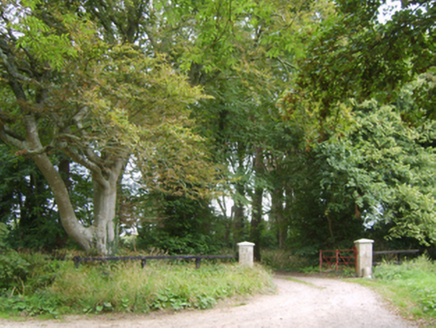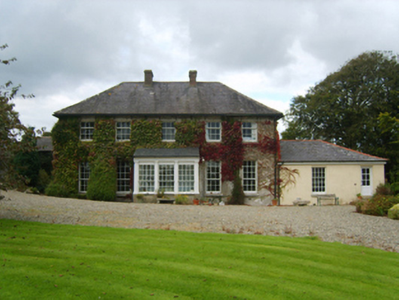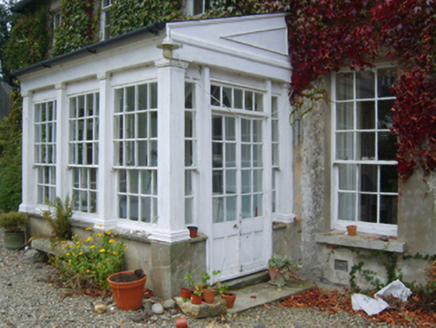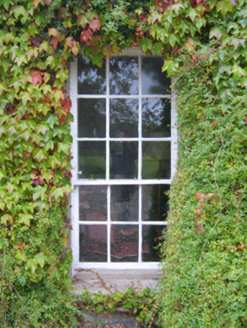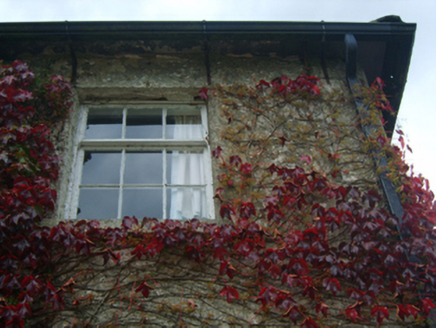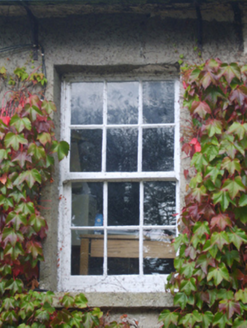Survey Data
Reg No
15704540
Rating
Regional
Categories of Special Interest
Architectural, Artistic, Historical, Social
Original Use
Farm house
In Use As
Farm house
Date
1800 - 1822
Coordinates
285190, 110801
Date Recorded
06/09/2007
Date Updated
--/--/--
Description
Detached five-bay (two-bay deep) two-storey farmhouse, extant 1822, on a cruciform plan centred on single-bay single-storey lean-to projecting glazed porch to ground floor; single-bay (two-bay deep) full-height central return (north). Vacant, 1851. Occupied, 1901; 1911. Hipped slate roof on a T-shaped plan centred on pitched slate roof (north), clay or terracotta ridge tiles, paired red brick Running bond central chimney stacks having corbelled stepped capping, and replacement uPVC rainwater goods on slate flagged eaves. Part creeper- or ivy-covered fine roughcast wall to front (south) elevation with rusticated rendered piers to corners; lime rendered surface finish (remainder). Segmental-headed central door opening into farmhouse with concealed dressings framing glazed timber panelled double doors having fanlight. Square-headed window openings with cut-granite sills, and concealed dresings framing nine-over-six (ground floor) or three-over-six (first floor) timber sash windows without horns. Interior including (ground floor): central hall retaining carved timber surrounds to door openings framing timber panelled doors; and carved timber surrounds to door openings to remainder framing timber panelled doors with carved timber surrounds to window openings framing timber panelled shutters. Set in landscaped grounds with granite ashlar piers to perimeter having cut-granite shallow pyramidal capping supporting cast-iron double gates.
Appraisal
A farmhouse representing an integral component of the early nineteenth-century domestic built heritage of south County Wexford with the architectural value of the composition, one labelled as tenanted by 'Mr. Wm. Marchant' on the map titled "Kiltra" from the "Survey of THE ESTATE OF Anthony Cliffe Esquire in the COUNTIES of WEXFORD Cork Kilkenny and MEATH" (1822) by Sherrard's Brassington and Greene, confirmed by such attributes as the compact plan form centred on a restrained doorcase showing a simple radial fanlight, albeit one largely concealed behind a later porch; and the diminishing in scale of the openings on each floor producing a graduated visual impression. Having been well maintained, the elementary form and massing survive intact together with substantial quantities of the original fabric, both to the exterior and to the interior, including crown or cylinder glazing panels in hornless sash frames: meanwhile, contemporary joinery; chimneypieces; and sleek plasterwork refinements, all highlight the artistic potential of the composition. Furthermore, adjacent outbuildings (----) continue to contribute positively to the group and setting values of a self-contained ensemble having historic connections with William Marchant (1789-1851); and the Boyd family including James Boyd MD (1817-92) '[who was] for nearly fifty years Medical Officer of the Bannow Dispensary District' (cf. 15704519; 15704520; 15704608); John Bagenal Boyd JP (1855-1935), Land Agent for the Boyses of Bannow House (see 15704543); and Arthur John Bagenal Boyd (1912-83).
